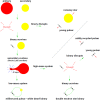Binary Neutron Star Mergers
- PMID: 28163622
- PMCID: PMC5255524
- DOI: 10.12942/lrr-2012-8
Binary Neutron Star Mergers
Abstract
We review the current status of studies of the coalescence of binary neutron star systems. We begin with a discussion of the formation channels of merging binaries and we discuss the most recent theoretical predictions for merger rates. Next, we turn to the quasi-equilibrium formalisms that are used to study binaries prior to the merger phase and to generate initial data for fully dynamical simulations. The quasi-equilibrium approximation has played a key role in developing our understanding of the physics of binary coalescence and, in particular, of the orbital instability processes that can drive binaries to merger at the end of their lifetimes. We then turn to the numerical techniques used in dynamical simulations, including relativistic formalisms, (magneto-)hydrodynamics, gravitational-wave extraction techniques, and nuclear microphysics treatments. This is followed by a summary of the simulations performed across the field to date, including the most recent results from both fully relativistic and microphysically detailed simulations. Finally, we discuss the likely directions for the field as we transition from the first to the second generation of gravitational-wave interferometers and while supercomputers reach the petascale frontier.
Figures


















Similar articles
-
Coalescence of Black Hole-Neutron Star Binaries.Living Rev Relativ. 2011;14(1):6. doi: 10.12942/lrr-2011-6. Epub 2011 Aug 29. Living Rev Relativ. 2011. PMID: 28163619 Free PMC article. Review.
-
Binary neutron star mergers: a review of Einstein's richest laboratory.Rep Prog Phys. 2017 Sep;80(9):096901. doi: 10.1088/1361-6633/aa67bb. Epub 2017 Mar 20. Rep Prog Phys. 2017. PMID: 28319032
-
Neutrino transport in general relativistic neutron star merger simulations.Living Rev Comput Astrophys. 2023;9(1):1. doi: 10.1007/s41115-023-00016-y. Epub 2023 Feb 23. Living Rev Comput Astrophys. 2023. PMID: 36852009 Free PMC article. Review.
-
Neutron star merger remnants.Gen Relativ Gravit. 2020;52(11):108. doi: 10.1007/s10714-020-02752-5. Epub 2020 Nov 10. Gen Relativ Gravit. 2020. PMID: 39247669 Free PMC article. Review.
-
Numerical relativity of compact binaries in the 21st century.Rep Prog Phys. 2019 Jan;82(1):016902. doi: 10.1088/1361-6633/aadb16. Epub 2018 Aug 17. Rep Prog Phys. 2019. PMID: 30117809
Cited by
-
BINARY NEUTRON STAR MERGERS: A JET ENGINE FOR SHORT GAMMA-RAY BURSTS.Astrophys J Lett. 2016 Jun 10;824(1):L6. doi: 10.3847/2041-8205/824/1/L6. Epub 2016 Jun 3. Astrophys J Lett. 2016. PMID: 29881539 Free PMC article.
-
Prospects for Observing and Localizing Gravitational-Wave Transients with Advanced LIGO and Advanced Virgo.Living Rev Relativ. 2016;19(1):1. doi: 10.1007/lrr-2016-1. Epub 2016 Feb 8. Living Rev Relativ. 2016. PMID: 28179853 Free PMC article. Review.
-
Rotating stars in relativity.Living Rev Relativ. 2017;20(1):7. doi: 10.1007/s41114-017-0008-x. Epub 2017 Nov 29. Living Rev Relativ. 2017. PMID: 29225510 Free PMC article. Review.
-
Quantum expander for gravitational-wave observatories.Light Sci Appl. 2019 Dec 11;8:118. doi: 10.1038/s41377-019-0230-2. eCollection 2019. Light Sci Appl. 2019. PMID: 31839938 Free PMC article.
-
Gravitational Radiation from Post-Newtonian Sources and Inspiralling Compact Binaries.Living Rev Relativ. 2014;17(1):2. doi: 10.12942/lrr-2014-2. Epub 2014 Feb 13. Living Rev Relativ. 2014. PMID: 28179846 Free PMC article. Review.
References
-
- Abadie J, LIGO Scientific Collaboration. Virgo Collaboration et al. Predictions for the rates of compact binary coalescences observable by ground-based gravitational-wave detectors. Class. Quantum Grav. 2010;27:173001. doi: 10.1088/0264-9381/27/17/173001. - DOI
-
- Abbott BP, LIGO Scientific Collaboration et al. Search for gravitational waves from low mass binary coalescences in the first year of LIGO’s S5 data. Phys. Rev. D. 2009;79:122001. doi: 10.1103/PhysRevD.79.122001. - DOI
-
- Akmal A, Pandharipande VR, Ravenhall DG. The equation of state of nucleon matter and neutron star structure. Phys. Rev. C. 1998;58:1804–1828. doi: 10.1103/PhysRevC.58.1804. - DOI
-
- Alcubierre M. Introduction to 3+1 Numerical Relativity. Oxford; New York: Oxford University Press; 2008.
-
- Alford M, Braby M, Paris MW, Reddy S. Hybrid stars that masquerade as neutron stars. Astrophys. J. 2005;629:969–978. doi: 10.1086/430902. - DOI
Publication types
LinkOut - more resources
Full Text Sources
